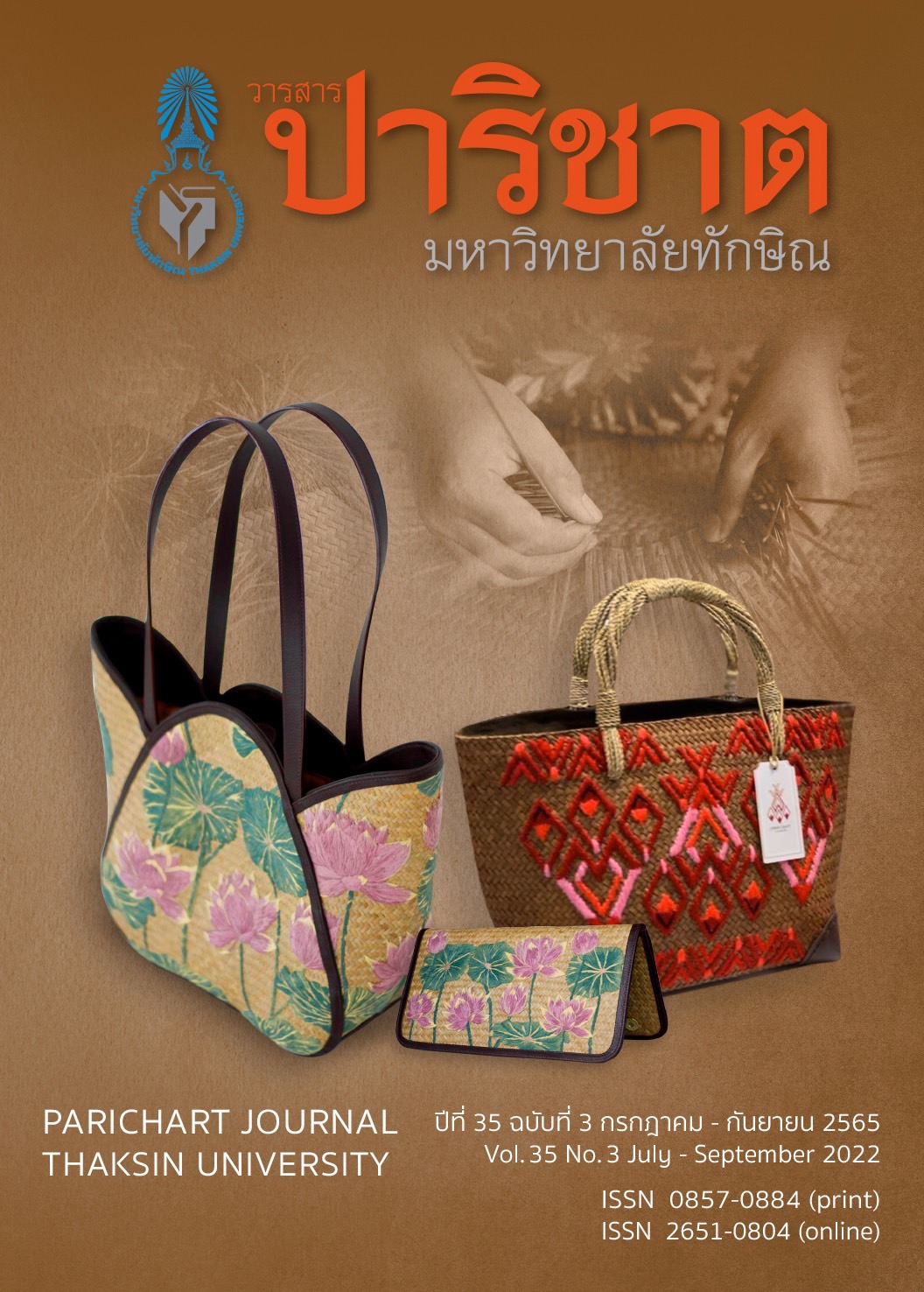Influence of Entrepreneurial Autonomy and Logistics Service Innovation on Delivery of Logistics Entrepreneurs Under COVID-19 Pandemic in Thailand
Main Article Content
Abstract
The purpose of this paper is to analyze the casual relationship model among entrepreneurial autonomy, logistics service innovation and logistics delivery under COVID-19 pandemic in Thailand. The population was 1,012 logistics entrepreneurs in Thailand. The samplings were entrepreneurs/executive chairman/executive: one from each company, totaling 322 samples. The data were collected by using questionnaires. Concerning data analysis, the exploratory factor analysis, the confirmatory factor analysis and path analysis were employed. The results showed that the model fitted in the empirical data. Entrepreneurial autonomy and logistics service innovation have positive direct effect on logistics delivery at the 0.01 significant level. The logistics entrepreneurs with entrepreneurial autonomy could encourage employees to develop initiatives or logistics service innovation implementation for organization goals achievement; delivery, problem solving and customers need responding under volatile economic environment as a consequence COVID-19 pandemic or new infectious diseases that may occur in the future.
Article Details

This work is licensed under a Creative Commons Attribution-NonCommercial-NoDerivatives 4.0 International License.
References
World Health Organization. (2020, March 12). WHO announces COVID-19 outbreak a pandemic. http://www.euro.who.int/en/health-topics/health-emergencies/coronavirus-covid-19/news/news/2020/3/who-announces-covid-19-outbreak-apandemic.
Donthu, N., & Gustafsson, A. (2020). Effects of COVID-19 on business & research. Journal of Business Research, 117, 284-289.
World Trade Organization. (2020, October 3). Trade set to plunge as COVID-19 pandemic upends global economy. https://www.wto.org/english/news_e/pres20_e/pr855_e.htm.
Fiscal Policy Office of Thailand. (2020, August 7). Thailand’s economic outlook 2020. http://www.fpo.go.th/main/Economic-report/Thailand-Economic-Projections/13242.aspx. (In Thai)
Jaenglom, K. & Tantipidok, P. (2020, September 20). Transport & logistics 2020. Industry Review 2020. https://www.scbeic.com/th/detail/file/product/6563/fjvy8kfdv8/EIC_Industry-review_ parcel_20200120.pdf. (In Thai)
Johanssen, M., Keränen, J., Hinterhuber, L., & Andersson, L. (2015). Value assessment & pricing capabilities-how to profit from value. Journal of Revenue & Pricing Management, 14(3), 178-197.
Cui, L., Su, S. I. I., & Hertz, S. (2012). Logistics innovation in China. Transportation Journal, 51(1), 98-117.
Jara, M., Vyt, D., Mevel, O., Morvan, T. & Morvan, N. (2018). Measuring customers benefits of click & collect. Journal of Services Marketing, 32(4), 430-442.
Bhattarai, A. (2020, April 16). Grocery delivery was supposed to be the ultimate pandemic lifeline: but it’s falling short. The Washington Post. https://www.washingtonpost.com/business/2020/04/15/grocery-delivery-coronavirus.
Dodds, L. (2020, April 13). Amazon hires another 75,000 staff to cope with Covid-19 demand. The Telegraph. https://www.telegraph.co.uk/technology/2020/04/.13/amazon-hires-another-75000-staff-cope-covid-19-demand.
Gawke, J. C., Gorgievski, M. J., & Bakker, A. B. (2017). Employee intrapreneurship & work engagement: a latent change score approach. Journal of Vocational Behavior, 100, 88-100.
Shan, P., Song, M., & Ju, X. (2015). Entrepreneurial orientation & performance: is innovation speed a missing link? Journal of Business Research, 69(1), 683-690. http://dx.doi.org/10.1016/j.jbusres.2015.08.032.
Chu, Z., et al. (2018). Logistics service innovation by third party logistics providers in China: aligning Guanxi & organization structure. Transportation Research Part E, 118, 291-307. https://doi.org/10.1016/j.tre.2018.08.007.
Grawe, S. J., Daugherty, P. J., & Ralston, P. M. (2015). Enhancing dyadic performance through boundary spanners & innovation: an assessment of service provider-customer relationship. Journal of Business Logistics, 36(1), 88-101.
Tanskanen, K., Holmström, J., & Öhman, M. (2015). Generative mechanisms of adoption of logistics innovation: the case of on-site shops in construction supply chains. Journal of Business Logistics: Strategic Supply Chain Research, 36(2), 139-159. https://doi.org/10.1111/jbl.12089.
Wang, G., et al. (2016). Big data analytic in logistics & supply chain management: certain investigations for research & applications. International Journal Production Economics, 176(2016), 98-110. http://dx.doi.org/10.1016/j.ijpe.2016.03.014.
Lumpkin, G. T., & Dess, G. G. (2009). Understanding & measuring autonomy: an entrepreneurial orientation perspective. entrepreneurship Theory & Practice, 33(1), 47-69. https://doi.org/10.1111/j.1540-6520.2008.00280.x.
Wang, M., Jie, F., & Abareshi, A. (2015). Evaluating logistics capability for mitigation of supply chain uncertainty & risk in the Australian courier firms. Asia Pacific Journal of Marketing and Logistics, 27(3), 486-498. https://doi.org/10.1108/APJML-11-2014-0157.
Hair, J. F., Jr., Black, W. C., Babin, B. J., & Anderson, R. E. (2014). Multivariate data analysis. (7th ed). Pearson Education.
Karimi, J. & Walter, Z. (2016). Corporate entrepreneurship, disruptive business model innovation adoption, & its performance: the case of the newspaper industry. Long Range Planning, 49, 342-360.
Mapalala, M. J. (2017). Examining the relationship between entrepreneurial orientation & organization performance: the moderating role of organizational learning. (Doctor of Philosophy Dissertation). Organizational Leadership, Regent University, USA.
Yu, K., Cadeaux, J., & Song, H. (2016). Flexibility & quality in logistics & relationship. Industrial Marketing Management, 62, 211-225. http://dx.doi.org/10.1016/j.indmarman.2016.09.004.
Rowinelli, R. J., & Hambleton, R. K. (1977). On the use of content specialists in the assessment of criterion-referenced test item validity. Dutch Journal for Educational Research, 2.
Nunnally, J. C., & Bernstein, I. H. (1994). Psychometric theory. (3nd ed). McGraw-Hill.
Chang, C. H., & Lai, P. L. (2017). An evaluation of logistics policy enablers between Taiwan & the UK. Maritime Business Review, 2(1), 2-20. https://doi.org/10.1108/MABR-09-2016-0018.
Carmines, E. G. & Zeller, R. A. (1980). Reliability & Validity Assessment. SAGE Publications.
Costello, A. B., & Osborne, J. W. (2005). Best practices in exploratory factor analysis: four recommendations for getting the most from your analysis. Practical Assessment, Research, & Evaluation, 10(7), 1-9. https://doi.org/10.7275/jyj1-4868.
Fornell, C., & Larcker, D. F. (1981). Evaluating structural equation models with unobservable variables & measurement error. Journal of Marketing Research, 18(1), 39-50.


